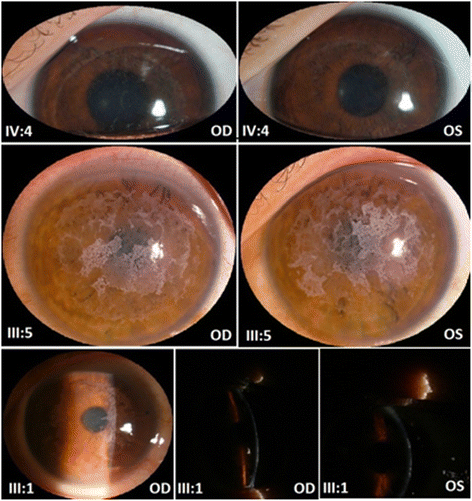A novel phenotype-genotype correlation with an Arg555Trp mutation of TGFBI gene in Thiel-Behnke corneal dystrophy in a Chinese pedigree
- PMID: 26464103
- PMCID: PMC4605025
- DOI: 10.1186/s12886-015-0121-0
A novel phenotype-genotype correlation with an Arg555Trp mutation of TGFBI gene in Thiel-Behnke corneal dystrophy in a Chinese pedigree
Abstract
Background: To investigate the molecular defects in a four-generation Chinese pedigree affected with Thiel-Behnke corneal dystrophy (TBCD). And to further study the relationship between genetic mutation and clinical manifestations.
Methods: Individuals of the pedigree were recruited for extensive ophthalmic examinations. Histological studies of two corneal buttons obtained from lamellar keratoplasty were conducted. Peripheral blood was collected in EDTA for genomic DNA isolation from leukocytes of all affected and unaffected members. All 17 exons of the TGFBI gene were screened for mutations by polymerase chain reaction and direct DNA sequencing.
Results: Clinical examinations revealed a typical pattern of honeycomb-like TBCD. Histopathology study demonstrated eosinophilic deposits that were congo-red-positive and did not stain with periodic acid Schiff or Masson's trichrome. Genetic analysis disclosed a heterozygous p. Arg555Trp mutation resulted from a missense c. 1663C > T nucleotide change in exon 12 of TGFBI gene in all affected members. Morever, a second rare variant in exon 6 of the TGFBI gene (p. Arg257Trp) also cosegregated within this family and has been confirmed to be a single nucleotide polymorphism (SNP) not previously reported.
Conclusions: The p. Arg555Trp mutation of the TGFBI gene was associated with TBCD, which revealed a novel phenotype-genotype correlation within the mutational spectrum of phenotypically diverse corneal dystrophies.
Figures




Similar articles
-
A novel phenotype-genotype relationship with a TGFBI exon 14 mutation in a pedigree with a unique corneal dystrophy of Bowman's layer.Mol Vis. 2008 Aug 18;14:1503-12. Mol Vis. 2008. PMID: 18728790 Free PMC article.
-
Arg124Cys mutation of the TGFBI gene in 2 Chinese families with Thiel-Behnke corneal dystrophy.Arch Ophthalmol. 2009 May;127(5):641-4. doi: 10.1001/archophthalmol.2009.71. Arch Ophthalmol. 2009. PMID: 19433713
-
Late-onset lattice corneal dystrophy without typical lattice lines caused by a novel mutation in the TGFBI gene.Cornea. 2014 Mar;33(3):294-9. doi: 10.1097/ICO.0000000000000062. Cornea. 2014. PMID: 24473223
-
[Autosomal dominant inherited corneal dystrophies associated with TGFBI mutation].Nippon Ganka Gakkai Zasshi. 2001 Oct;105(10):659-72. Nippon Ganka Gakkai Zasshi. 2001. PMID: 11692612 Review. Japanese.
-
Analysis of TGFBI gene mutations in Chinese patients with corneal dystrophies and review of the literature.Mol Vis. 2010 Jun 30;16:1186-93. Mol Vis. 2010. PMID: 20664689 Free PMC article. Review.
Cited by
-
Novel mutation in the TGFBI gene in a Moroccan family with atypical corneal dystrophy: a case report.BMC Med Genomics. 2021 Jan 6;14(1):9. doi: 10.1186/s12920-020-00861-3. BMC Med Genomics. 2021. PMID: 33407479 Free PMC article.
References
-
- Stone EM, Mathers WD, Rosenwasser GO, Holland EJ, Folberg R, Krachmer JH, et al. Three autosomal dominant corneal dystrophies map to chromosome 5q. Nat Genet. 1994;6:47–51. - PubMed
-
- Small KW, Mullen L, Barletta J, Graham K, Glasgow B, Stern G, et al. Mapping of Reis-Bucklers’ corneal dystrophy to chromosome 5q. Am J Ophthalmol. 1996;121:384–90. - PubMed
-
- Munier FL, Korvatska E, Djemai A, Le Paslier D, Zografos L, Pescia G, et al. Kerato-epithelin mutations in four 5q31-linked corneal dystrophies. Nat Genet. 1997;15:247–51. - PubMed
-
- Behnke H, Thiel HJ. A previously unrecognized form of subepithelial corneal dystrophy inherited as an autosomal dominant. Ger Med Mon. 1967;12:285. - PubMed
Publication types
MeSH terms
Substances
Supplementary concepts
LinkOut - more resources
Full Text Sources
Other Literature Sources
Miscellaneous

